新加坡南洋理工大学TPT考试回顾
- 格式:docx
- 大小:37.84 KB
- 文档页数:5

2019南洋理工大学本科生招生考核方式及启示*韦骅峰摘 要:南洋理工大学是“一带一路”沿线的世界一流大学。
目前南洋理工大学实行多元化的本科生招生考核方式,将GCE A-Level考试、新加坡理工学院文凭、新加坡国立大学高中文凭、国际文凭、其他国家和地区高中文凭和特殊人才自主招生,都纳入到其招生考核方式中,呈现学院招生自主权大、考核评价方式多元化和招生对象国际化等特点。
多元化的招生考核方式是基于新加坡政府统一领导的教育制度、双轨制的学制特点、培养创新人才和国际化办学的需要而形成的。
我国也应立足现实国情,制定适合本国的高校招生制度;适当扩大二级学院的招生自主权;贯彻“综合评价,多元录取”的改革方针,探索多种招生考核方式。
关键词:南洋理工大学;招生考核方式;多元化1977年恢复高考以来,我国高校入学一直以高考分数作为最主要依据。
近年来,高校招生考核方式的多元化探索是高考改革的重要方向。
个别省市如浙江、上海等进行了高考综合改革试点,开展了“综合评价、多元录取”选拔制度改革的探索实践,在统一考试的基础上,将学生水平考试和综合素质评价纳入高校招生考核的评价体系[1]。
目前,高考综合改革仍处于试点阶段,需要广泛借鉴他国经验。
新加坡作为与我国有着紧密文化联结的东南亚近邻,其高校招生制度值得研究与借鉴。
本文选取新加坡名校南洋理工大学为对象,通过剖析其本科生招生办法,提炼其对我国高考改革尤其是一流大学招生的有益启示。
新加坡的南洋理工大学,尽管1991年才正式更名成为一所综合性研究型大学,然而,经过不到30年的发展,该校在2018年的QS世界大学排名中名列第11位,在QS建校50年以内的大学排名中名列第1,已经成为享誉世界的一流大学,共有31827名来自92个国家和地区的学生在此学习[2]。
南洋理工大学基于新加坡的现实国情、高等教育体制和高校自身发展规划,制定出了多元化的本科生招生考核方式,这一制度的成功经验值得我国“双一流”建设高校学习,也有助于推动我国高考改革向“综合评价、多元录取”的方向迈进。
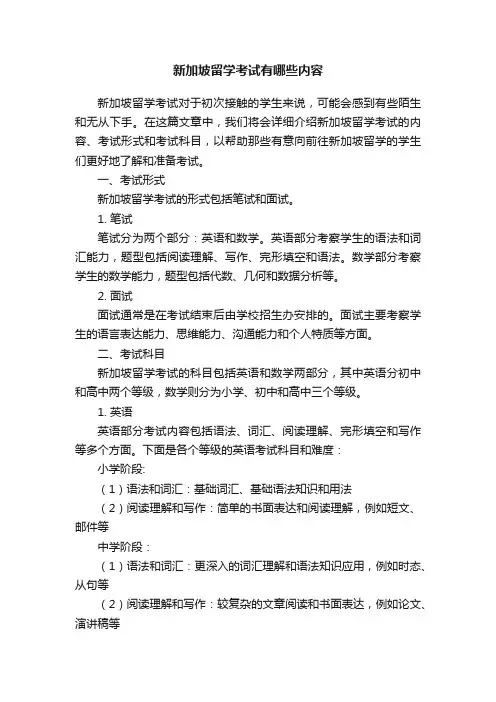
新加坡留学考试有哪些内容新加坡留学考试对于初次接触的学生来说,可能会感到有些陌生和无从下手。
在这篇文章中,我们将会详细介绍新加坡留学考试的内容、考试形式和考试科目,以帮助那些有意向前往新加坡留学的学生们更好地了解和准备考试。
一、考试形式新加坡留学考试的形式包括笔试和面试。
1. 笔试笔试分为两个部分:英语和数学。
英语部分考察学生的语法和词汇能力,题型包括阅读理解、写作、完形填空和语法。
数学部分考察学生的数学能力,题型包括代数、几何和数据分析等。
2. 面试面试通常是在考试结束后由学校招生办安排的。
面试主要考察学生的语言表达能力、思维能力、沟通能力和个人特质等方面。
二、考试科目新加坡留学考试的科目包括英语和数学两部分,其中英语分初中和高中两个等级,数学则分为小学、初中和高中三个等级。
1. 英语英语部分考试内容包括语法、词汇、阅读理解、完形填空和写作等多个方面。
下面是各个等级的英语考试科目和难度:小学阶段:(1)语法和词汇:基础词汇、基础语法知识和用法(2)阅读理解和写作:简单的书面表达和阅读理解,例如短文、邮件等中学阶段:(1)语法和词汇:更深入的词汇理解和语法知识应用,例如时态、从句等(2)阅读理解和写作:较复杂的文章阅读和书面表达,例如论文、演讲稿等高中阶段:(1)语法和词汇:语法知识深入,词汇量扩充,例如语气、虚拟语气等(2)阅读理解和写作:较高难度的文章阅读和论文写作等。
2. 数学数学部分的考试内容包括代数、几何和数据分析等方面。
下面是各个等级的数学考试科目和难度:小学阶段:(1)数学基础知识:数字、计算和逻辑等基础知识(2)代数和几何:简单的代数和几何基础中学阶段:(1)数学基础知识:扩充的数字、计算和逻辑知识,并通过应用掌握基本数学公式(2)代数和几何:深入代数和几何知识,例如方程、不等式、三角函数等(3)数据分析:统计、概率等知识基本概念和应用高中阶段:(1)数学基础知识:深入掌握数学公式并能够在各种数学问题中应用(2)代数和几何:深入代数和几何知识,例如微积分等(3)数据分析:理论和实践的深入应用三、考试内容的难度与备考建议新加坡留学考试难度具有一定的挑战性,但是只要准备充分,掌握一定的技巧,就可以顺利通过考试。
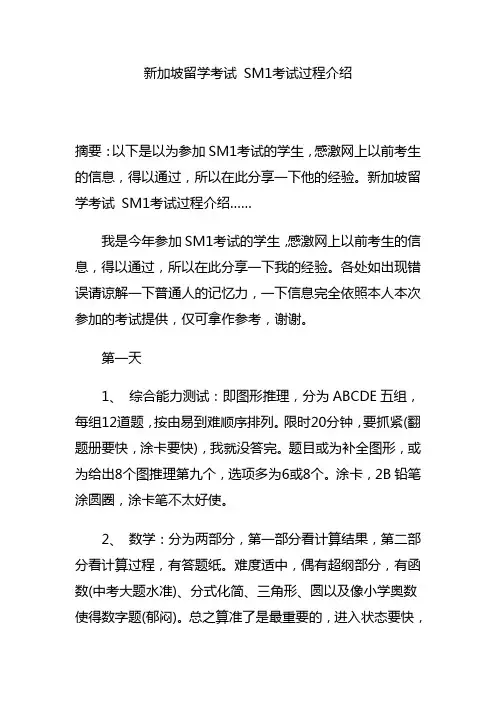
新加坡留学考试 SM1考试过程介绍摘要:以下是以为参加SM1考试的学生,感激网上以前考生的信息,得以通过,所以在此分享一下他的经验。
新加坡留学考试 SM1考试过程介绍……我是今年参加SM1考试的学生,感激网上以前考生的信息,得以通过,所以在此分享一下我的经验。
各处如出现错误请谅解一下普通人的记忆力,一下信息完全依照本人本次参加的考试提供,仅可拿作参考,谢谢。
第一天1、综合能力测试:即图形推理,分为ABCDE五组,每组12道题,按由易到难顺序排列。
限时20分钟,要抓紧(翻题册要快,涂卡要快),我就没答完。
题目或为补全图形,或为给出8个图推理第九个,选项多为6或8个。
涂卡,2B铅笔涂圆圈,涂卡笔不太好使。
2、数学:分为两部分,第一部分看计算结果,第二部分看计算过程,有答题纸。
难度适中,偶有超纲部分,有函数(中考大题水准)、分式化简、三角形、圆以及像小学奥数使得数字题(郁闷)。
总之算准了是最重要的,进入状态要快,检查时间也不要放过。
3、英语:分两部分,第一部分包括4项选择题(选适当的词填空)、完型(在给定的次中选适当的词填在文章空白出)&(在一片有空白的文章中自选词填入)、阅读(选择题)&(按给出英文释义,在指定段落中找出相应词汇)。
有答题卡。
第二部分为作文,题材二选一,400或500字(我记不清了),30分钟(好像是),时间紧(我这水准的听到监考老师说剩5分钟时只好匆匆结尾了)。
4、华文:人家让偶们写个作文,不许超过600字,多了不给纸!(我估计是批卷老师最多受得了看600字的中文作文,呵呵,开玩笑了)。
创意写作,题目让我想吐,不过加油,大家的文笔肯定比我好。
P.S:Some Tips(仅为猜测)将会的东西答对,不会的尽努力。
他们不是挑的不一定是天才,所以嘛,我们也可以哟!第二天面试:偶面对3老师,2人提问,1人拿个笔记本电脑一言不发。
1、然我读一篇英文文章,先默读,后出声读。
(看英语对话水平吧)2、英文提问:你怎样学习?你怎样学英语?3、老师觉得我太紧张了,改中文提问:你去过新加坡或是其他国家吗?做一下自我介绍?就自我介绍提问。
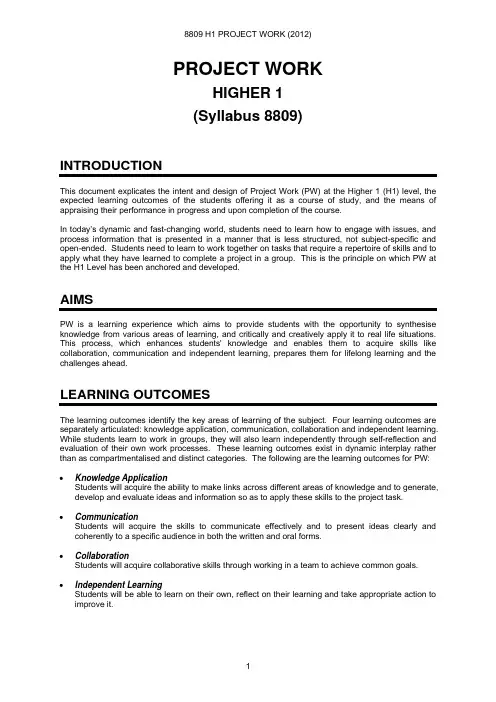
PROJECT WORKHIGHER 1(Syllabus 8809)INTRODUCTIONThis document explicates the intent and design of Project Work (PW) at the Higher 1 (H1) level, the expected learning outcomes of the students offering it as a course of study, and the means of appraising their performance in progress and upon completion of the course.In today’s dynamic and fast-changing world, students need to learn how to engage with issues, and process information that is presented in a manner that is less structured, not subject-specific and open-ended. Students need to learn to work together on tasks that require a repertoire of skills and to apply what they have learned to complete a project in a group. This is the principle on which PW at the H1 Level has been anchored and developed.AIMSPW is a learning experience which aims to provide students with the opportunity to synthesise knowledge from various areas of learning, and critically and creatively apply it to real life situations. This process, which enhances students' knowledge and enables them to acquire skills like collaboration, communication and independent learning, prepares them for lifelong learning and the challenges ahead.LEARNING OUTCOMESThe learning outcomes identify the key areas of learning of the subject. Four learning outcomes are separately articulated: knowledge application, communication, collaboration and independent learning. While students learn to work in groups, they will also learn independently through self-reflection and evaluation of their own work processes. These learning outcomes exist in dynamic interplay rather than as compartmentalised and distinct categories. The following are the learning outcomes for PW:∙Knowledge ApplicationStudents will acquire the ability to make links across different areas of knowledge and to generate, develop and evaluate ideas and information so as to apply these skills to the project task.∙CommunicationStudents will acquire the skills to communicate effectively and to present ideas clearly and coherently to a specific audience in both the written and oral forms.∙CollaborationStudents will acquire collaborative skills through working in a team to achieve common goals.∙Independent LearningStudents will be able to learn on their own, reflect on their learning and take appropriate action to improve it.ASSESSMENT OBJECTIVESThe assessment in PW aims to measure the extent to which the students have achieved the expected learning outcomes. During the course, the students have to demonstrate their ability, individually and as a group, by applying the knowledge learned to develop a project task.Students will be assessed in the following areas:∙Knowledge ApplicationCandidates are expected to demonstrate the ability to generate, develop and evaluate ideas and information so as to apply these skills as they carry out a project task.∙CommunicationCandidates are expected to demonstrate the ability to present ideas clearly and coherently to a specific audience in both the written and oral forms.NOTE: Collaboration and Independent Learning are not assessed.ASSESSMENT FRAMEWORKStudents are assigned to work in project groups, with each project group having 4 to 5 members. The project groups are to work on a task that is designed to be broad enough to allow students to display their various skills and abilities. The groups are expected to complete the task within 28 weeks (recommended time of 60–75 hours, assuming an average of 2.5 hours per week) where they will define the project focus, analyse and evaluate the information gathered, prepare an oral presentation and submit a written report.Students will be assessed on their performance both as members of the group and as individuals. Assessment is made of students carrying out the project and of the final products delivered.The performance of individual students and that of groups is assessed through the following means: written report, oral presentation and the group project file.Table 1 shows the assessment criteria, and Table 2 shows the assessment framework.∙Written ReportAt the end of the project, each group is required to submit a piece of written work based on the task that they have completed. This component assesses students on their performance pertaining to knowledge application and written communication. Only a group mark is awarded for this component; this is to encourage the group to apply the skills that they have learned and to demonstrate their abilities collectively in a final product.∙Oral PresentationEach student from the group is given an opportunity to present a part of the project orally to a target audience and answer questions posed to the individual student. The students will be assessed as individuals and as a group. Emphasis is placed on every student being able to display, individually, his ability to be clear and coherent in presenting his ideas and to address and engage an audience. A group mark is given to recognise the group’s ability to be organised and coherent throughout the oral presentation.∙Group Project FileStudents will be assessed on their abilities to generate and develop ideas, and analyse and evaluate the information they have gathered. Students are expected to show evidence of these processes through the following documents: Preliminary Ideas, Evaluation of relevant print/non-print Material and Insights and Reflections.Table 1: Assessment CriteriaComponents of Assessment IndividualGroupWritten Report∙ Substantiation of ideas∙ Generation of ideas ∙ Analysis andevaluation of ideas ∙Formal exposition of 2500–3000 words∙ Sources must beacknowledged∙ Organisation of ideasOral Presentation∙ Fluency and clarity of speech∙ Effectiveness of oral presentation ∙ Awareness of audience ∙ Response to questions ∙Max. 25 min. per group for groups with 4 students; max. 30 min. for groups with 5 students∙ At least 5 min. per student ∙ May include grouppresentation not exceeding 5 min∙ Q & A sessionGroup Project File∙Individual submission:∙ Preliminary Ideas ∙ Evaluation of relevantprint/non-print Material ∙ Insights and Reflections∙ Generation of ideas ∙ Analysis andevaluation of ideasTable 2: Assessment FrameworkComponent Group Individual TotalWritten Report 40% - 40% Oral Presentation 10% 30% 40% Group Project File-20%20%Total 50% 50% 100%Assessment CriteriaWritten ReportAssessment requirements:∙Formal exposition of around 2500–3000 words ∙Sources must be acknowledgedCriterionNomark ApproachingExpectationMeetingExpectationExceedingExpectationGroupSubstantiation of ideas Main ideas aresupported by fewrelevant details andexamplesMain ideas aresupported by relevantdetails and examplesMain ideas are wellsupported by relevantdetails and examplesGeneration of ideas Ideas are largelyrehashed with little orno modificationIdeas areappropriatelymodified and/ordevelopedIdeas are insightfuland/or innovativeAnalysis and evaluation of ideas Ideas are analysedand evaluated in alimited wayIdeas are sufficientlyanalysed andevaluatedIdeas are thoroughlyanalysed andevaluatedOrganisation of ideas Criterion has not been met Ideas are presentedand organised insuch a way that thereport is difficult tofollowIdeas are presentedand organised insuch a way that thereport is easy tofollowIdeas are presentedand organisedcoherentlyOral PresentationAssessment requirements:∙ Max. 25 min. per group for groups with 4 students; max. 30 min. for groups with 5 students ∙ At least 5 min. per student∙ May include group presentation not exceeding 5 min. ∙ Question & Answer sessionCriterion No. mark Approaching Expectation Meeting ExpectationExceeding ExpectationIndividualFluency andclarity of speech Speaks haltingly and/or mumbles, and is difficult to understand at timesSpeaks clearly and intelligibly most of the time Speaks clearly and fluently throughout, at an appropriate paceAwareness of audience Shows little awareness of audience Shows some awareness of audience Shows personal engagement withaudience Response to questions Criterion has not been met Answers are limited with little or no elaboration Answers are relevant and contain some elaboration of ideas Answers are relevant, well thought out and elaborated on GroupEffectiveness of grouppresentationCriterion has not been metPresentation has limited effect due to lack of cohesion and organisation.Presentation aids do not enhance the presentationPresentation isgenerally effective with some degree of cohesion and organisation.Presentation aids used appropriately toenhance presentationPresentation is highly effective, cohesive and well-organised.Presentation aids used to effectively enhance overall effectGroup Project FileAssessment requirements:∙Individual submission: Preliminary Ideas, Evaluation of relevant print/non-print Material, Insights and Reflections∙Group submission: Group Project Proposal (Note: Groups are required to submit this although this is not assessed)CriterionNomark ApproachingExpectationMeeting ExpectationExceedingExpectationIndividualGeneration of ideas Ideas are largelyrehashed with little orno modification Ideas are appropriatelymodified and/ordevelopedIdeas are insightfuland/or innovativeAnalysis and evaluation of ideas Criterion has not been met Ideas are analysed and evaluated in a limited way Ideas are sufficiently analysed and evaluated Ideas are thoroughly analysed and evaluated。
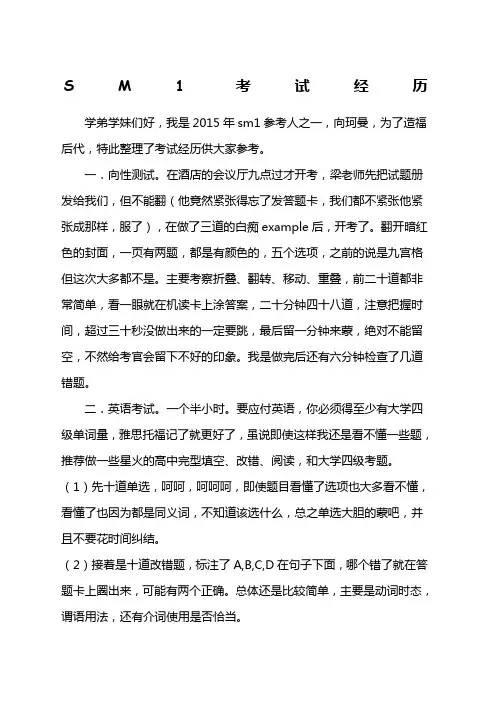
S M1考试经历学弟学妹们好,我是2015年sm1参考人之一,向珂曼,为了造福后代,特此整理了考试经历供大家参考。
一.向性测试。
在酒店的会议厅九点过才开考,梁老师先把试题册发给我们,但不能翻(他竟然紧张得忘了发答题卡,我们都不紧张他紧张成那样,服了),在做了三道的白痴example后,开考了。
翻开暗红色的封面,一页有两题,都是有颜色的,五个选项,之前的说是九宫格但这次大多都不是。
主要考察折叠、翻转、移动、重叠,前二十道都非常简单,看一眼就在机读卡上涂答案,二十分钟四十八道,注意把握时间,超过三十秒没做出来的一定要跳,最后留一分钟来蒙,绝对不能留空,不然给考官会留下不好的印象。
我是做完后还有六分钟检查了几道错题。
二.英语考试。
一个半小时。
要应付英语,你必须得至少有大学四级单词量,雅思托福记了就更好了,虽说即使这样我还是看不懂一些题,推荐做一些星火的高中完型填空、改错、阅读,和大学四级考题。
(1)先十道单选,呵呵,呵呵呵,即使题目看懂了选项也大多看不懂,看懂了也因为都是同义词,不知道该选什么,总之单选大胆的蒙吧,并且不要花时间纠结。
(2)接着是十道改错题,标注了A,B,C,D在句子下面,哪个错了就在答题卡上圈出来,可能有两个正确。
总体还是比较简单,主要是动词时态,谓语用法,还有介词使用是否恰当。
(3)完型填空1。
给了时态,20个词15个空,有些单词不认识,要注意分词性,动词名词形容词,根据句子需要什么词选择,再依照是否符合句意,从而得出答案。
(4)完形填空2。
什么也不给,就填空,都是介词,非常简单,只要掌握了语法和短语是没问题的。
(5)两篇阅读。
比较长,第一题在文中选所给的5个单词的近义词,第二题解释划线的代词的含义,如that,it,these,第三题选择题,根据文章内容选择。
三、作文。
三十分钟。
发给你作文纸,两个题目选择一个,写大约250词的作文,这次的题目是你为获得更好教育所作出的努力、与最好朋友的误解(第一题看不懂,毅然决然地选了第二题)。
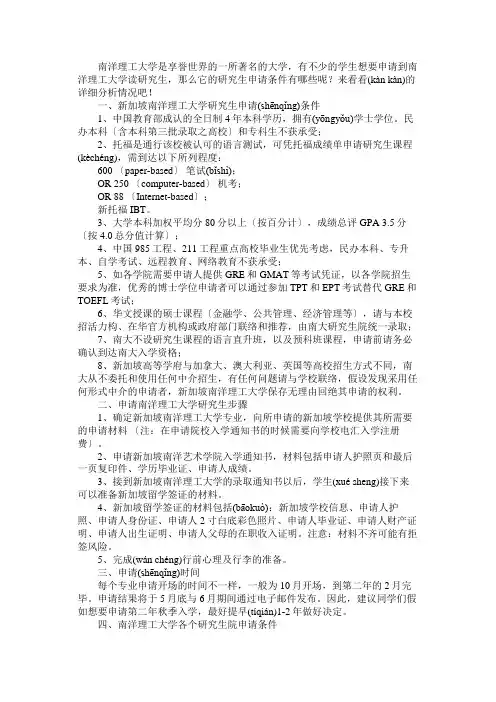
南洋理工大学是享誉世界的一所著名的大学,有不少的学生想要申请到南洋理工大学读研究生,那么它的研究生申请条件有哪些呢?来看看(kàn kàn)的详细分析情况吧!一、新加坡南洋理工大学研究生申请(shēnqǐng)条件1、中国教育部成认的全日制4年本科学历,拥有(yōngyǒu)学士学位。
民办本科〔含本科第三批录取之高校〕和专科生不获承受;2、托福是通行该校被认可的语言测试,可凭托福成绩单申请研究生课程(kèchéng),需到达以下所列程度:600 〔paper-based〕笔试(bǐshì);OR 250 〔computer-based〕机考;OR 88 〔Internet-based〕;新托福IBT。
3、大学本科加权平均分80分以上〔按百分计〕,成绩总评GPA 3.5分〔按4.0总分值计算〕;4、中国985工程、211工程重点高校毕业生优先考虑,民办本科、专升本、自学考试、远程教育、网络教育不获承受;5、如各学院需要申请人提供GRE和GMAT等考试凭证,以各学院招生要求为准,优秀的博士学位申请者可以通过参加TPT和EPT考试替代GRE和TOEFL考试;6、华文授课的硕士课程〔金融学、公共管理、经济管理等〕,请与本校招活力构、在华官方机构或政府部门联络和推荐,由南大研究生院统一录取;7、南大不设研究生课程的语言直升班,以及预科班课程,申请前请务必确认到达南大入学资格;8、新加坡高等学府与加拿大、澳大利亚、英国等高校招生方式不同,南大从不委托和使用任何中介招生,有任何问题请与学校联络,假设发现采用任何形式中介的申请者,新加坡南洋理工大学保存无理由回绝其申请的权利。
二、申请南洋理工大学研究生步骤1、确定新加坡南洋理工大学专业,向所申请的新加坡学校提供其所需要的申请材料〔注:在申请院校入学通知书的时候需要向学校电汇入学注册费〕。
2、申请新加坡南洋艺术学院入学通知书,材料包括申请人护照页和最后一页复印件、学历毕业证、申请人成绩。

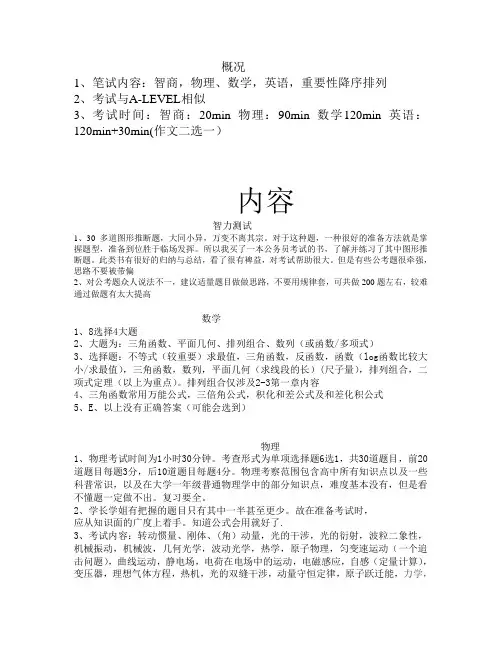
概况1、笔试内容:智商,物理、数学,英语,重要性降序排列2、考试与A-LEVEL相似3、考试时间:智商:20min 物理:90min 数学120min 英语:120min+30min(作文二选一)内容智力测试1、30多道图形推断题,大同小异,万变不离其宗。
对于这种题,一种很好的准备方法就是掌握题型,准备到位胜于临场发挥。
所以我买了一本公务员考试的书,了解并练习了其中图形推断题。
此类书有很好的归纳与总结,看了很有裨益,对考试帮助很大。
但是有些公考题很牵强,思路不要被带偏2、对公考题众人说法不一,建议适量题目做做思路,不要用规律套,可共做200题左右,较难通过做题有太大提高数学1、8选择4大题2、大题为:三角函数、平面几何、排列组合、数列(或函数/多项式)3、选择题:不等式(较重要)求最值,三角函数,反函数,函数(log函数比较大小/求最值),三角函数,数列,平面几何(求线段的长)(尺子量),排列组合,二项式定理(以上为重点)。
排列组合仅涉及2-3第一章内容4、三角函数常用万能公式,三倍角公式,积化和差公式及和差化积公式5、E、以上没有正确答案(可能会选到)物理1、物理考试时间为1小时30分钟。
考查形式为单项选择题6选1,共30道题目,前20道题目每题3分,后10道题目每题4分。
物理考察范围包含高中所有知识点以及一些科普常识,以及在大学一年级普通物理学中的部分知识点,难度基本没有,但是看不懂题一定做不出。
复习要全。
2、学长学姐有把握的题目只有其中一半甚至更少。
故在准备考试时,应从知识面的广度上着手。
知道公式会用就好了.3、考试内容:转动惯量、刚体、(角)动量,光的干涉,光的衍射,波粒二象性,机械振动,机械波,几何光学,波动光学,热学,原子物理,匀变速运动(一个追击问题),曲线运动,静电场,电荷在电场中的运动,电磁感应,自感(定量计算),变压器,理想气体方程,热机,光的双缝干涉,动量守恒定律,原子跃迁能,力学,热学,电磁学,运动学,原子物理,波动力学(了解),介子,重子(要做题)只要学过,一定会做,越偏难度越小,大学内容记住公式即可解题。
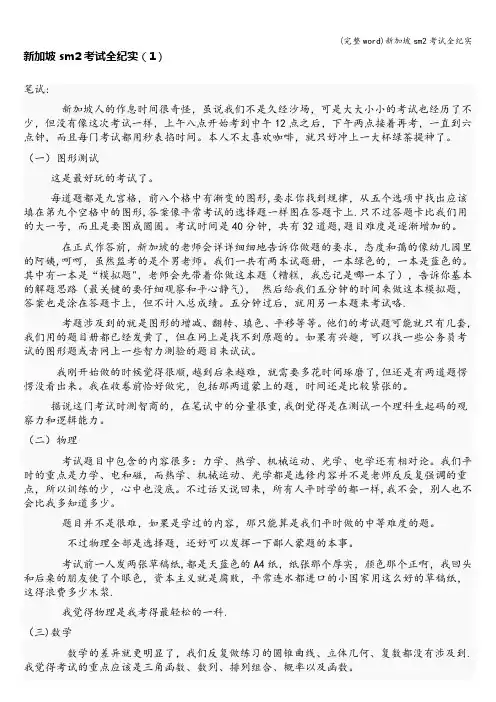
新加坡sm2考试全纪实(1)笔试:新加坡人的作息时间很奇怪,虽说我们不是久经沙场,可是大大小小的考试也经历了不少,但没有像这次考试一样,上午八点开始考到中午12点之后,下午两点接着再考,一直到六点钟,而且每门考试都用秒表掐时间。
本人不太喜欢咖啡,就只好冲上一大杯绿茶提神了。
(一)图形测试这是最好玩的考试了。
每道题都是九宫格,前八个格中有渐变的图形,要求你找到规律,从五个选项中找出应该填在第九个空格中的图形,答案像平常考试的选择题一样图在答题卡上.只不过答题卡比我们用的大一号,而且是要图成圆圈。
考试时间是40分钟,共有32道题,题目难度是逐渐增加的。
在正式作答前,新加坡的老师会详详细细地告诉你做题的要求,态度和蔼的像幼儿园里的阿姨,呵呵,虽然监考的是个男老师。
我们一共有两本试题册,一本绿色的,一本是蓝色的。
其中有一本是“模拟题",老师会先带着你做这本题(糟糕,我忘记是哪一本了),告诉你基本的解题思路(最关键的要仔细观察和平心静气), 然后给我们五分钟的时间来做这本模拟题,答案也是涂在答题卡上,但不计入总成绩。
五分钟过后,就用另一本题来考试咯.考题涉及到的就是图形的增减、翻转、填色、平移等等。
他们的考试题可能就只有几套,我们用的题目册都已经发黄了,但在网上是找不到原题的。
如果有兴趣,可以找一些公务员考试的图形题或者网上一些智力测验的题目来试试。
我刚开始做的时候觉得很顺,越到后来越难,就需要多花时间琢磨了,但还是有两道题愣愣没看出来。
我在收卷前恰好做完,包括那两道蒙上的题,时间还是比较紧张的。
据说这门考试时测智商的,在笔试中的分量很重,我倒觉得是在测试一个理科生起码的观察力和逻辑能力。
(二)物理考试题目中包含的内容很多:力学、热学、机械运动、光学、电学还有相对论。
我们平时的重点是力学、电和磁,而热学、机械运动、光学都是选修内容并不是老师反反复强调的重点,所以训练的少,心中也没底。
不过话又说回来,所有人平时学的都一样,我不会,别人也不会比我多知道多少。
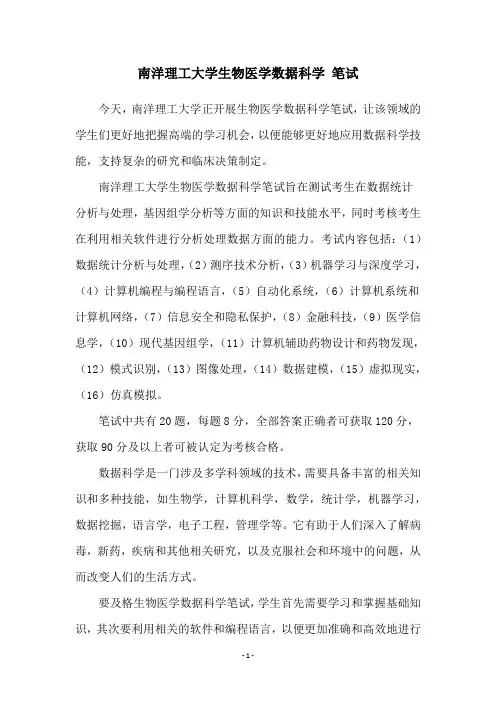
南洋理工大学生物医学数据科学笔试今天,南洋理工大学正开展生物医学数据科学笔试,让该领域的学生们更好地把握高端的学习机会,以便能够更好地应用数据科学技能,支持复杂的研究和临床决策制定。
南洋理工大学生物医学数据科学笔试旨在测试考生在数据统计分析与处理,基因组学分析等方面的知识和技能水平,同时考核考生在利用相关软件进行分析处理数据方面的能力。
考试内容包括:(1)数据统计分析与处理,(2)测序技术分析,(3)机器学习与深度学习,(4)计算机编程与编程语言,(5)自动化系统,(6)计算机系统和计算机网络,(7)信息安全和隐私保护,(8)金融科技,(9)医学信息学,(10)现代基因组学,(11)计算机辅助药物设计和药物发现,(12)模式识别,(13)图像处理,(14)数据建模,(15)虚拟现实,(16)仿真模拟。
笔试中共有20题,每题8分,全部答案正确者可获取120分,获取90分及以上者可被认定为考核合格。
数据科学是一门涉及多学科领域的技术,需要具备丰富的相关知识和多种技能,如生物学,计算机科学,数学,统计学,机器学习,数据挖掘,语言学,电子工程,管理学等。
它有助于人们深入了解病毒,新药,疾病和其他相关研究,以及克服社会和环境中的问题,从而改变人们的生活方式。
要及格生物医学数据科学笔试,学生首先需要学习和掌握基础知识,其次要利用相关的软件和编程语言,以便更加准确和高效地进行数据分析,同时还要培养自己的实践能力,以应对复杂的研究课题,开展更深入的研究工作。
生物医学数据科学笔试是南洋理工大学试图更好地满足学生及提升整体水平的努力,代表着对这一领域科学未来发展的了解。
经过这次笔试,学生们将更加深入地理解数据科学的重要性,可以利用它实现研究。
此外,学生也可以从中学习如何管理数据,使用软件来收集和清理数据,以及如何发挥数据科学在日常工作中的重要作用。
总而言之,南洋理工大学生物医学数据科学笔试对学生而言既有挑战又有机会,可以帮助他们更好地掌握数据科学的知识和技能,支持复杂的研究和临床决策制定,有助于改变人们的生活方式,更加高效地人们的研究工作,最终实现社会的发展。
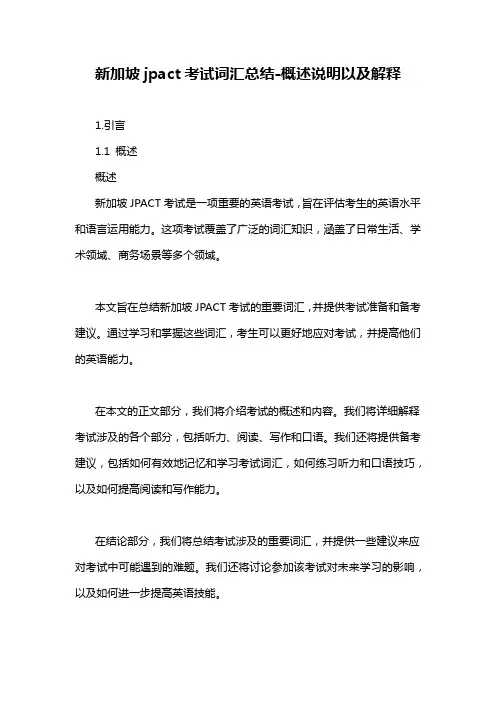
新加坡jpact考试词汇总结-概述说明以及解释1.引言1.1 概述概述新加坡JPACT考试是一项重要的英语考试,旨在评估考生的英语水平和语言运用能力。
这项考试覆盖了广泛的词汇知识,涵盖了日常生活、学术领域、商务场景等多个领域。
本文旨在总结新加坡JPACT考试的重要词汇,并提供考试准备和备考建议。
通过学习和掌握这些词汇,考生可以更好地应对考试,并提高他们的英语能力。
在本文的正文部分,我们将介绍考试的概述和内容。
我们将详细解释考试涉及的各个部分,包括听力、阅读、写作和口语。
我们还将提供备考建议,包括如何有效地记忆和学习考试词汇,如何练习听力和口语技巧,以及如何提高阅读和写作能力。
在结论部分,我们将总结考试涉及的重要词汇,并提供一些建议来应对考试中可能遇到的难题。
我们还将讨论参加该考试对未来学习的影响,以及如何进一步提高英语技能。
总而言之,本文将为考生提供一份全面的新加坡JPACT考试词汇总结和备考建议。
希望本文能够为考生提供有益的指导,并帮助他们顺利通过考试,提高英语水平。
1.2文章结构1.2 文章结构本文将按照以下结构进行论述:1. 引言1.1 概述- 介绍新加坡JPACT考试的背景和重要性,为读者提供了解该考试的基本概念。
1.2 文章结构- 提供了本文的整体结构,让读者明确了解每个部分的内容。
1.3 目的- 阐述本文的写作目标和意义,为读者建立了阅读的动机。
2. 正文2.1 考试概述- 详细介绍了新加坡JPACT考试的背景,包括考试的历史、目的和评估标准等方面的内容。
2.2 考试内容- 对新加坡JPACT考试的各个部分进行了全面而详细的介绍,包括听力、阅读、口语和写作等方面的内容。
2.3 考试准备- 提供了备考新加坡JPACT考试的有效方法和建议,包括词汇积累、模拟考试和学习技巧等方面的内容。
3. 结论3.1 总结考试词汇- 对新加坡JPACT考试中常见的词汇进行总结和归纳,为考生提供了备考的重要参考资料。
Exam:190-622Titl e :Notes Domino 6 Managing Servers and Users��Ver : 01.09.06QUESTION 1Which one of the following explains why Hans cannot retrieve an HTML file whichhe knows is on the Domain server?A. The CGI script are not enabled.B. The default URL is set to ?Open.C. Hans has Depositor access to the Domino server.D. The HTML files are not located in the HTML directory listed in the server or Web site configuration documents.Answer: AQUESTION 2Jim's Notes workstation's Smart Upgrade did not work. Which one of the following could be the cause of Smart Upgrade failing?A. Jim did not access his mail database.B. Jim's Personal Address Book has the filename JIM.NSF.C. Jim's Location document does not correctly specify his home server.D. Jim does not have administrator access to his Windows 2000 workstation. Answer: AQUESTION 3When a policy selected for a particular user?A. During registrationB. During workstation setupC. When the user's certifier ID is createdD. When the user accesses their mail serverAnswer: BQUESTION 4Jessica wants to assign an explicit policy to a user. Which one of the following documents should be modified to assign the policy to the user?A. The policy documentB. The user's Person documentC. The office Location documentD. The mail server's configuration documentAnswer: BQUESTION 5Which one of the following statements about the Smart Upgrade database isTRUE?A. The database must have ODS version 41.B. The database must have the filesystem SMUPKIT.NSFC. The database must contain the relevant Notes RS information.D. The database must exist on at least one server in the domain.Answer: DQUESTION 6Amy wants to decommission an existing source server. Before transferring the applications, she runs a Decommission Server Analysis report. Which one of the following types of information does this tool provide?A. Source server information onlyB. Target server information onlyC. A compression between source server and target serverD. A detailed report of everything transferred from the souce server to te target server once the transfer takes placeAnswer: CQUESTION 7In addition to Notes database, which one of the following files on a Domino server should be backed up in order that new users can created in case of the server?A. The CACHE.DSK fileB. Certifier ID filesC. The user's DESKTOP.DSK fileD. The server's BOOKMARK.NSF file.Answer: BQUESTION 8Brie left the Create New Replicas field blank in a Server document. Who can create new replica databases on that server?A. No oneB. AdministratorsC. Local Domain ServerD. Everyone in the domainAnswer: AQUESTION 9Which one of the following statements about the compact server task is TRUE?A. The compact process re-indexes views.B. By default, compact runs every day at 3 P.M.C. Compact may be scheduled via a program document.D. Compact is listed in the TASKS line on all Notes 6/6.5 workstations.Answer: CQUESTION 10Josh has cross certified the /BOX organization to his /ACME organization. An administrator from the BOX organization has cross certified the /ACME to the/BOX organization. When a /BOX server attempts to assess a /ACME server, it receives a " You are not authorized to access this server" error. Which one of the following could be the cause of this error?A. The Box server's ID does not contain a copy of the Acme certifier.B. The Box server's ID file needs to be updated with the cross certificate.C. The Box administrator needs to add the Box server to the LocalDomainServer group.D. The Box server has not been granted access to the Acme server in the Acme server document.Answer: DQUESTION 11Suzanne, a Notes administrator sets the "Allow Anonymous Notes connections" setting in the Server document to yes. Which one of the following levels of accesswill Bob, Notes user, have when he accesses a database with the following settings:-Default- Editor*/ACME - ReaderAnonymous - AuthorOtherDomainServer -NoAccessA. ReaderB. AuthorC. DefaultD. No AccessAnswer: BQUESTION 12Amy is setting up session-based name-and-password authentication. Which one ofthe following is required for this to work?A. JavaB. COBRAC. CookiesD. JavaScriptAnswer: CQUESTION 13Jeff cross certified the Organizational Unit (OU) /NYC/ACME with his organization's /BOX Organizational (O) certifier. Which one of the following statements are correct for this scenario?A. Users or server with /NYC/BOX certificate can access /ACME servers.B. Users with an ACME ID can access any of Box's severs that have a /NYC/BOX certificate.C. Any user or server ID with the /NYC/ACME certificate can access any server in the /BOX organization if they have the appropriate cress certificate.D. Server with the /NYC/ACME certificate can access any server in the /BOX organization if they have the appropriate cress certificate but no .NYC/AME user can access /BOX servers.Answer: AQUESTION 14Robert's windows 200 Domain server has frozen with no error output on theserver's screen or other indication that anything is wrong. Which on of the followig can cause this problem?A. The server was replicating with another serverB. The server's transaction log was being updated.C. Robert has forced mail routing to another server.D. Microsoft windows Quick Edit mode was enabled for the server console window. Answer: DQUESTION 15Bob left the Create New Databases field empty in a Server document. Who is authorized to create new databases on the server?A. No oneB. Administrators onlyC. LocalDomainServer onlyD. Anyone with access to the serverAnswer: DQUESTION 16Which one of the following statements about transaction logging is TRUE?A. The transaction log is always named TRANSLG.NSFB. Transaction logging must be enabled on all Domain 6/6.5 servers.C. All database changes are written to a transaction log in a batch.D. Transaction logging is enabled by default on all Domain 6/6.5 servers. Answer: CQUESTION 17Raul wants to review reads and writes to databases from various Notes user. Where would he locate this information?A. LOG.NSFB. DOMLOG.NSFC. ACTINFO.NSFD. ACTIVIOTY.NSFAnswer: AQUESTION 18Which one of the following statements about Domino SSL server security is TRUE?A. SSL must be enabled for all server ports.B. SSL can only be enabled for POP3, IMAP and SMTP.C. If a server is using SSL, users must access the server using a browser.D. You can require SSL connections for all databases on a server or for an individual database.Answer: DQUESTION 19Dawn used the Administration Process (AdminP) to convert a non-roaming Note user to a roaming Notes user. In which one of the following does the Administration Process update the user's status from non-roaming to roaming?A. Person documentB. Server documentC. Location documentD. Configuration documentAnswer: AQUESTION 20Orin changes the name of a group using the Domino Administrator client. How often does the Administration process (AdminP) update group names in Author and Reader Names fields?A. DailyB. HourlyC. WeeklyD. ImmediatelyAnswer: CQUESTION 21Jonathan has been moved out of one group and into another. How long before this change will be effective throughout the seventeen servers in his domain?A. One hour.B. ImmediatelyC. It is dependent on the replication schedule for NAMES.NSF.D. The Administrator Process (AsminP) will change his group membership throughout the domain within 24 hours.Answer: CQUESTION 22Maria got married ad changed her last name. She needs to have her name changedin the Domino Directory. Which one of the Following actions did the administrator use to change Maria's name?A. Edit PersonB. Move to folderC. Rename Selected PeopleD. Recertify Selected PeopleAnswer: CQUESTION 23Karen uses the Administration Process (AdminP) to move a user's main file to a different mail server. Which one of the following must Karen do in order for thenew mail file to be created and the old mail file to be deleted?A. Update the user's Location documents.B. Modify the mailserver field in the user's person documentC. Approve the deletion of the old mail file in the ADMIN4.NSF database.D. Give the user rights to create new databases on the new mail server.Answer: CQUESTION 24When a user is deleted from the Domino Directory, which one of the following tasks must be approved in the ADMIN4.NSF database by the administrator before theAdministration process (AdminP) performs the task?A. Remove the user from groups.B. Delete the user's mail database.C. Add the user to a Terminations groupD. Remove the Person document from the domain's Domino Directly.Answer: BQUESTION 25Jennifer is moving user from /Madrid/ACME to /Boston/ACME. Which one of the following will she need to perform this task?A. The Web Administrator clientB. Just the destination certifierC. Author access to the domain's Domino DirectoryD. Both the /Madrid/ACME and the /Boston/ACME certifier ID filesAnswer: DQUESTION 26Which one of the following processes ensures that group names in ACLs are updated when an administrator changes the name of the group in the domain's Domino Directory?A. UpdateB. UpdallC. ConvertD. Administration Process (AdminP)Answer: DQUESTION 27Which one of the following may cause the error "You are not authorized to use the server on remote consol"?A. The user is not authorized to use the server.B. The server does not allow remote administration.C. The user's ID file is not cress certified with the server.D. The person in not listed in the Administrators field of the Server document. Answer: DQUESTION 28Jose wants to see the replication topology map of his Notes domain. To see this topology, what must he do?A. Load the MAPS EXTRACTOR server task.B. Load the TOPMAPS EXTRACTOR server task.C. Load the MAPTOP EXTRACTOR server task.D. Load the TOPOLOGY EXTRACTOR server task.Answer: AQUESTION 29Which one of the following would be helped by using the Mail Trace feature?A. A user cannot read encrypted e-mail.B. All mail messages to a particular user are not routing properly.C. Mail is not routing from outside your domain to your domain's mail servers.D. Mail messages from one user in your domain are not routing properly to external users.Answer: BQUESTION 30Geoff wants to force replication of NAMES.NSF between ServerA/Acme and ServerB/Acme. Which one of the following console commands will accomplish this?A. LOAD REPLICATIONB. REP SERVERA SERVERBC. REP SERVERB/ACME NAMESD. TELL SERVERA REP SERVERB NAMESAnswer: CQUESTION 31Both Server A and Server B are in the domain and in the same Domain Network Name. What is the minimum number of Connection Documents needed for replication to occur in both directions?A. TwoB. OneC. ThreeD. NoneAnswer: BQUESTION 32Which one of the following may prevent the Administration Process (AdimnP)from updating a user's name in their ID file?A. The user accepted the name change.B. The CERTLOG.NSF database does not include a copy of the user's certificate.C. The user's name is not listed in the Domino Directory's Access Control List (ACL).D. The user did not accept the name change in the first twenty-four hours after the administrator initiated it.Answer: BQUESTION 33An agent that is designed to run "On schedule more than once daily" does not complete. Which one of the following could cause this problem?A. The agent must be initiated by user action.B. The agent can only run hourly, weekly or monthly.C. The developer must start the agent manually the first time.D. The agent has exceeded the value in the Max Execution time in the Agent Manager settings of the Server document.Answer: DQUESTION 34Koki, a Domino administrator, is trying to move a server within the certification hierarchy by running the administration Process task. He recertifies the server witha different certifier ID but the change never tasks place. Which one of the following will cause the recertifying process to fail?A. The server has a hierarchical certificate.B. The Administration Process was enabled.C. The Certification Log was placed on the Domino Administrator workstation.D. A replica copy of the Administration Requests database was placed was placed on every server in the domain.Answer: CQUESTION 35Which one of the following may cause the error "You are not autjorized to accessthe server"?A. The user's ID file has expired.B. The server's ID file has expired.C. The cross certificate exists on both directions.D. The Access List in the Server document denies the user access.Answer: DWhich one of the following types of information is stored in an .NSD file?A. Current server statusB. Notes storage directoriesC. Information regarding a system crashD. HTTP access information for the serverAnswer: CQUESTION 37Both Server A and Server B are in the Acme domain, are correctly listed in DNS, are in the same Domino Network Name. How many Connection Document are required mail to route for Server B and from Server A to Server B and form Server B to Server A?A. OneB. TwoC. ThreeD. NoneAnswer: DQUESTION 38Which one of the following may cause the error "Unable to find path to server" on a Notes workstation?A. The user's ID file has expired.B. Server's hostname is not resolving.C. The Personal Address Book has been deleted.D. Server does to have a Connection document to the server.Answer: BQUESTION 39Jeff is trying to create a replica of STATUS.NSF but is unable to create the local copy. Which one of the following could cause this problem?A. Jeff only has Reader access in the database's Access Control List (ACL).B. Jeff only has Author access in the database's Access Control List (ACL).C. Jeff only has Editor access in the database's Access Control List (ACL).D. Jeff has not been given the right to replicate or copy documents in the database's Access Control List (ACL).Answer: DWhat is the minimum level of access a Notes 6/6 5 user must have to run the Out of Office agent?A. AuthorB. EditorC. ManagerD. DesignerAnswer: BQUESTION 41Jose is creating a new password for himself. Which one of the following will password quality checking indicate as the least secure password?A. Mixed case passphrasesB. All uppercase passwordsC. Passphrases containing numbers and punctuationD. Would found in Notes dictionaries during spell checkAnswer: DQUESTION 42Kurt created an event generator. Which one of the following will this do?A. Restart the event task.B. Initiate a task a server.C. Create entries in the EVLOG.NSF databases.D. Monitor a task a task or statistic by probing a server.Answer: AQUESTION 43Which one of the following controls when an agent runs on a server?A. The Agent Manager taskB. Server document, Agent Settings field.C. Configuration document, Agent Setting filed.D. The AGENTSCHED parameter in the server's NOTES.INI file.Answer: BQUESTION 44Why did Sophia create an event handler?A. To define a threshold for a statistic.B. So that server sets quotas on database size.C. In order to have the server log events to the EVENTS4.NSF database.D. To be notified via page if the server's available disk space fails below 25%. Answer: DQUESTION 45What is the DOMLOG.NSF database used for?A. To track all users who access the Domino serverB. To track users who access the Domino server via HTTPC. To track users who access the Domino server via NNTPD. To track user who authenticate with the Domino server.Answer: BQUESTION 46Which one of the following best describes the available directory architecture in a Domino 6 domain?A. A centralized directory architectureB. Both distributed and centralized directory architecturesC. None of the answers applyD. A distributed directory architectureAnswer: BNotes & Domino 6 supports both a distributed directory architecture and a central directory architecture.In a Distributed Directory architecture in a Domino domain, in which all servers use the standard Domino Directory in a central directory architecture,some servers store Configuration Directories (contains configuration settings only) and then use the standard Domino Directories on remote servers for lookups. QUESTION 47What is the significance of Kit Type=1 and where is it located?A. Server, in the Notes.iniB. Workstation, in the server documentC. Workstation, in the Notes.iniD. Server, in the configuration documentAnswer: CSpecifies which program you are running:1 - Workstation2 - ServerQUESTION 48Which on of the following is the proper syntax for forcing replication via a Domino server console command?A. Replicate [databasename] servernameB. Replicate servername [databasename]C. Replicate sourceservname/sourcedatabasenamedestinatationservername/destinationdatabasenameD. Replicate servername/databasenameAnswer: BSyntax: Replicate servername [databasename]Description: Forces replication between two servers (the server where you enter this command and the server you specify). Use the server's full hierarchical name. If the server name is more than one word, enclose the entire name in quotes. To force replication of a particular database that the servers have in common, specify the database name after the server name. The initiating server (where you're currently working) first pulls changes from the other server, and then gives the other server the opportunity to pull changes from it. You can use this command to distribute changes quickly or to troubleshoot a replication or communication problem.QUESTION 49Mary needs to rebuild all used views in her database. Which one of the following commands could she issue on the Domino server console?A. UPDALL -ALLB. UPDALL -*C. UPDALL -RD. UPDALL -XAnswer: CRebuild: All used viewsUPDALL -RRebuilds all used views. Using this option is resource-intensive, so use it as a last resort to solve corruption problems with a specific database.QUESTION 50What database is created when you run the Decommission Server Analysis tool?A. Log AnalysisB. DecommissionC. Server analysisD. ResultsAnswer: DWhen you run the Decommission Server Analysis tool, you create a Results databasecontaining detailed information comparing the source server and the target server. The source server is the server being removed from service, and the target server is the server taking the place of the source server. The source and the target servers must be Domino servers that have hierarchical names and that are in the same domain.QUESTION 51Which of the following uniquely identifies a document across all replicas of a database?A. UNIDB. NotelIDC. ReplicalDD. OFIDAnswer: AThe UNID (universal ID) is a 32-character combination of hexadecimal digits (0-9, A-F) that uniquely identifies a document across all replicas of a database.QUESTION 52A Program document can not be used to run which of the following types of commands or programs?A. API programsB. UNIX shell scriptsC. OS/2 command filesD. Java appletsAnswer: DA Program document is used to automatically run a server task at a specific time. You can also use a Program document to run an OS/2 command file, a UNIX shell script or program, or an API program. You can use the Program document to schedule tasksand/or programs.QUESTION 53Sandra has migrated all of her users and applications from Nagano/CertFX toMoscow/CertFX. Which one of the following can she use to ensure she has transferred all database and settings?A. Tivoli Server Analyzer for Lotus DominoB. The administration client action "Show Server Difference"C. Cluster comparison toolD. Server decommission Analysis toolAnswer: DThe Decommission Server Analysis tool generates a categorized list of items that were analyzed. Each category represents a different aspect of a server's configuration thatneeds attention. Within each category, items are listed alphabetically. Each item lists any differences between the source and the target server's settings or values. In the Results database, you can view the categorized list of the items that were analyzed. QUESTION 54A Security Policy Settings document controls which of the following?A. The Notes and Internet passwordsB. None of the aboveC. The administration ECL as well as Notes and Internet passwordsD. The administration ECL as well as Internet passwordsAnswer: CA Security policy settings document controls the Administration ECL as well as Notes and Internet passwords.QUESTION 55Which one of the following can you specify in the setup profile when performing a seamless upgrade?A. To which groups the client must be addedB. Which mail file template to apply according to the Lotus Notes client versionC. All of the aboveD. Which address book template to apply according to the Lotus Notes client version Answer: BWhen the Domino server receives the call to upgrade a mail file template, the server checks for a Desktop policy settings document or Setup Profile assigned to the user. The Desktop policy settings document and the Setup Profile contain a "Mail Template Information" section. This section is new to Setup Profiles in Notes 6. In this section, you can specify which mail file template to apply according to the Lotus Notes client version. QUESTION 56Which one of the following is not an Event Generator document?A. TCP server even generatorB. NRPC server event generatorC. Task status event generatorD. Statistic event generatorAnswer: BMonitoring Configuration documents define and configure what constitutes an event and how the event is handled. You can also use these documents to customize the message that appears on screen when an event occurs. The Monitoring Configuration documents are stored in EVENTS4.NSF.Event Generator documents are also stored in the Monitoring Configuration database, EVENTS4.NSF.QUESTION 57Which one fo the following best describes the information that can be found in the DOMLOG.nsf database?A. Both Lotus Notes and web activity on the Domino serverB. Lotus Notes activity on the Domino serverC. Web activity on the Domino serverD. Activity trends and health reporting of the Domino serverAnswer: CYou can log your server activity and Web server requests to the Domino Web server log (DOMLOG.NSF) database. This option may be preferable if you want to create views and view data in different ways. Logging to a database is somewhat slower than logging to text files, especially at very busy sites, and the size of the database can become large so that maintenance becomes an issue. However, if you use the Domino Web server log, you can treat this information as you would other Notes databases, and you can use built-in features to analyze the results.QUESTION 58Michael needs to force replicate between the following two servers:Notes Hub/Tools/ CertkillerSametime Hub/Tools/ CertkillerMichael is using a remote console on SametimeMichael is using a remote console on Sametime Hub/Tools/ Certkiller . Which oneof the following Domino server console commands did he issue?A. REPLICATE NotesHubB. REPLICATE Notes HubC. REPLICATE Notes Hub/Tools/ CertkillerD. REPLICATE Notes Hub/Tools/ Certkiller "Answer: DSyntax: Replicate servername [databasename]Description: Forces replication between two servers (the server where you enter this command and the server you specify). Use the server's full hierarchical name. If the server name is more than one word, enclose the entire name in quotes. To force replication of a particular database that the servers have in common, specify the database name after the server name. The initiating server (where you're currently working) first pulls changes from the other server, and then gives the other server the opportunity to pull changes from it. You can use this command to distribute changes quickly or to troubleshoot a replication or communication problem.Which one of the following is not an available policy settings document?A. Ecplicit policiesB. Exception policiesC. Implied policiesD. Organizational policiesAnswer: CA policy is a collection of individual policy settings documents.There are three types of policies: Organizational policies, Explicit policies and Exception policies.Organizational policies are applied automatically to users or groups based on the organizational structure.Explicit policies, like they sound, are assigned explicitly. They apply settings directly to a user, instead of through the organizational hierarchy.Exception policies allow users to control their own user settings.QUESTION 60Which one of the following statements about transaction logging is TRUE?A. Transaction logging is used to support Domino clusteringB. Logged transactions are stored in memoryC. Logged transactions are written to disk in a batchD. Transaction logging is enabled by default on all Domino 6 serversAnswer: CTransaction logging captures all the changes that are made to databases and writes them to a transaction log. The logged transactions are written to disk in a batch when resources are available or at specified intervals.QUESTION 61Hoke needs to make design changes to forms and views of a production database.He plans to make the changes locally in a template and then have the server updatethe production database with the changes. Which one of the following server tasksdoes the administrator run in order for the changes to be propagated?A. The REPLICA server taskB. The FIXUP -D server taskC. The DESIGN server taskD. The UPDALL server taskAnswer: CThe DESIGN or designer task updates all database design elements from their master template(s). The DESIGN task runs daily by default at 1 AM.A user has been added to a group with author access in the salesdatabase. When she enters the database she finds that she is able to change her co-workers documents as well as her own. Why?A. She is listed individually in the ACL with reader accessB. The ACL has become corrupt and needs fixed upC. None of the aboveD. She is listed in another group in the ACL with editor accessAnswer: DA name is included in two or more groups. The name receives the access of the group with the highest access.QUESTION 63Many needs to rebuild all used views in her database. Which one of the following commands could she issue on the Domino server console?A. UPDALL -RB. UPDALL -XC. UPDALL -ALLD. UPDALL -*Answer: ARebuild: All used viewsUPDALL -RRebuilds all used views. Using this option is resource-intensive, so use it as a last resort to solve corruption problems with a specific database.QUESTION 64Which one of the following should not be included in a NNN?A. Domino servers on a WANB. Domino servers on Dial-upC. None of the aboveD. Domino servers on a LANAnswer: BThe Domino Server Setup program automatically places all servers that are in a Domino domain and that run the same network protocol in the same Notes named network (NNN). In the Server document, the setup program assigns each NNN a default name in the format portname network.After you complete the Server Setup program, rename the NNN for each network port in the Server document. It is useful if the name reflects both the location of the network and its protocol. For example, if your company has a TCP/IP network and has LANs in Boston and San Francisco, change the name of the NNN in Boston to "TCPIP Boston。
选择题(Multiple Choice)She _______ for five hours on the computer last night.A. workedB. has workedC. was workingD. had workedThe manager _______ to arrive at 9 a.m., but he didn't show up.A. was supposedB. supposedC. supposesD. has supposed_______ the time I got to the airport, the plane had already taken off.A. AtB. ByC. InD. On_______ is important to eat a balanced diet.A. ItB. ThatC. ThisD. WhatThe more you exercise, _______ healthy you will be.A. the moreB. moreC. theD. much填空题(Fill in the Blanks)My brother _______ (study) in the US for three years now.It was _______ (rain) heavily when I left the office last night._______ (not forget) to bring your umbrella with you tomorrow.The teacher _______ (explain) the problem to us in detail yesterday.She _______ (be) absent from class for two days.简答题(Short-answer Questions)Describe a person who has influenced you most in your life and explain why.What are the main challenges you face in learning English, and how do you plan to overcome them?Discuss the importance of technology in modern education and give examples.Explain the benefits of reading books regularly and how it has improved your life.What are your hobbies and interests? How do they help you in your daily life?。
高中生如何报考新加坡南洋理工大学新加坡南洋理工大学(Nanyang Technological University)是新加坡著名的四所公立大学之一,其文凭是受到中国教育部认可的,也是学生留学的首选院校,但是,国内的高中生想要考南洋理工大学的话,一般难度都是比较大的,如果一高考成绩做申请,起码是一本线上100分,所以,大部分的学生都是通过新加坡A水准考试申请的。
另外,高中生考南洋理工大学还需要准备相关的申请材料才可以。
高中生申请南洋理工大学条件高中生考南洋理工大学最多的选择就是参加新加坡A水准考试,新加坡A水准考试预备课程申请条件是需要是高中毕业或以上。
每年的3月报名,6月到11月考试,考试通过以后,学生就可以直接入学南洋理工大学本科。
另外,高中生考南洋理工大学的话,也可以凭借高考成绩一本线上100分左右。
语言的要求是雅思(IELTS)6.0分(单项成绩不低于5.5分)/托福(IBT)80分/SAT1阅读600分、写作600分。
高中生考南洋理工大学材料高中生考南洋理工大学入学通知书材料包括申请人护照第一页和最后一页复印件、申请人最高学历毕业证、申请人成绩。
高中生考南洋理工大学材料学生签证材料包括申请人出生证明的公证书原件、6张护照大小标准照、申请人护照第一页和最后一页复印件、申请人最高学历毕业证的公证书原件和申请人成绩单的公证书原件、学校报名费的银行汇票、银行存款证明的公证书原件、父母职业证明原件。
高中生考南洋理工大学优势新加坡南洋理工学院是全球规模最大的工程学院之一,也是亚洲三所同时获得欧洲质量发展体系及美国国际管理教育联合会两项国际认证的商学院之一。
新加坡南洋理工大学的学术与科研课程致力于将教学与实践相结合,获得各大成功企业及行业领袖的鼎力支持,取得了卓越的成绩。
高中生考南洋理工大学的话,还可以申请南洋理工大学的助学金,如果成绩非常好,也会获得学费全免的机会并领取每月800当地货币的生活费。
广州南洋理工职业学院工作人员招聘笔试真题(满分100分时间120分钟)一、单选题(每题只有一个正确答案,答错、不答或多答均不得分)1.教育部《关于进一步加强高校实践育人工作的若干意见》强调,要加大博士学位论文抽检范围和力度,每年抽查比例不低于()A.2%B.5%C.3%D.6%【答案】:B2.我国把()周岁这段时期划分为青年期,同时也是加入团组织的年龄界限。
A.14-28B.12-28C.15-30D.14-25【答案】:A3.高等学校院(系)级单位党组织通过(),讨论和决定本单位重要事项。
A.院长办公会议B.党政联席会议C.院党委(支委)会D.教职工代表大会【答案】:B4.高校实践育人工作主要包括哪些形式()A.实践教学、军政训练、社会实践活动B.实践教学、志愿服务、创新创业C.课外活动、军政训练、社会实践活动1/ 12D.课外活动、志愿服务、创新创业【答案】:A5.高等学校的教师的聘任,应当遵循()的原则,由高等学校校长与受聘教师签订聘任合同。
A.服从学校发展需要B.双方平等自愿C.学校规章制度确立D.由教师自己申请【答案】:B6.在高等学校的教学方法中,()也称假设法或探究法。
A.发现教学法B.案例教学法C.项目教学法D.问题教学法【答案】:A7.教师的师德修养,只有在()中才能得到不断的充实、提高和完善。
A.思考B.实践C.学习D.交往【答案】:B8.不少大学生恋爱态度呈现轻率化的现象表现为()。
A.主观学业第一,客观爱情至上B.“儿女情长,英雄气短”C.“不求天长地久,但求曾经拥有”D.“爱人只有一个,情人可以多个”【答案】:C9.下列有关大学生摆脱自卑心理的表述,错误的是()。
A.合理评价B.悦纳自己C.孤芳自赏2/ 12D.自我激励【答案】:C10.关于高校教师的专业发展,下列说法中,错误的是()。
A.高校教师的专业发展过程可以划分为若干阶段B.高校教师的专业发展既需要外部支持,也需要自身的省悟和努力C.高校教师的专业发展是一个伴随整个职业生涯的长期过程D.在走上工作岗位后,随着时间的推移,高校教师专业发展水平会自然地不断提升【答案】:D11.高校培养全面发展的高级专门人才的教育手段是()A.单靠社会实践B.做到教学、科研与社会实践三结合C.单靠科研D.单靠教学【答案】:B12.大学生在遇到困难与挫折时,往往因为只考虑眼前,很难全面、长远、多角度看待问题,从而容易悲观失望,难以自拔,这反映了其情绪情感的()。
新加坡奖学金考试SM3详解新加坡奖学金考试SM3(senior middle school 3)是1990年中新建交时新加坡与中国教育部达成的留学合作项目,新加坡教育部代表两所知名大学新加坡国立大学(National University of Singapore)和南洋理工大学(Nanyang Technological University)每年与国内十余所大学签约并从新生中选拔优秀学生并提供全额奖学金及生活补助,至2011年已经有20届。
笔试项目包括:综合能力测试、数学和英语。
一、综合能力测试:据说综合能力测试是三门考试中非常重要的一门,所谓的综合能力其实就是智商测试。
监考员首先会发给你一本习题册,然后带领考生一起做几道题,让你熟悉题型,这些题目是不算分的,不需要全部做完,只供热身之用。
然后监考员会发给考生一本真正的考试用的习题册,习题册上有36道题,全是图形逻辑题,不牵涉到数字问题,要求考生在40分钟内完成。
题目是由易到难的,前面的21道左右的题很简单,一般每道题只需10多秒或20多秒就能解决,最后的15道题会比较难,有的题目需要花费1分钟甚至几分种才能解决。
因此一定要掌握好时间,前面的容易题要做得又快又准,留出充裕的时间解答后面的难题。
具体体型与下面所给网站上的题目题型完全相同。
做完后,点交卷可以看到自己的IQ是多少,但是这个网站上的题目的答案没有公布,如果想要做下有答案的练习。
二、数学测试:数学测试每年的题量都有变化,一般是10道选择题与4到6道的解答题。
以2007年为例,试卷包括10道选择题(五选一,每题4分,共40分)与4道解答题(每题15分,共60分),试卷总分为100分。
试卷总题难度接近于全国高中数学联赛的一试难度,但要容易一些。
数学试题考查的范围大致包括函数,三角函数,数列,不等式,二相式定理,组合与排列,几何与平面几何等,有必要复习一下初中学过但现在不太熟练的内容,如平面几何等。